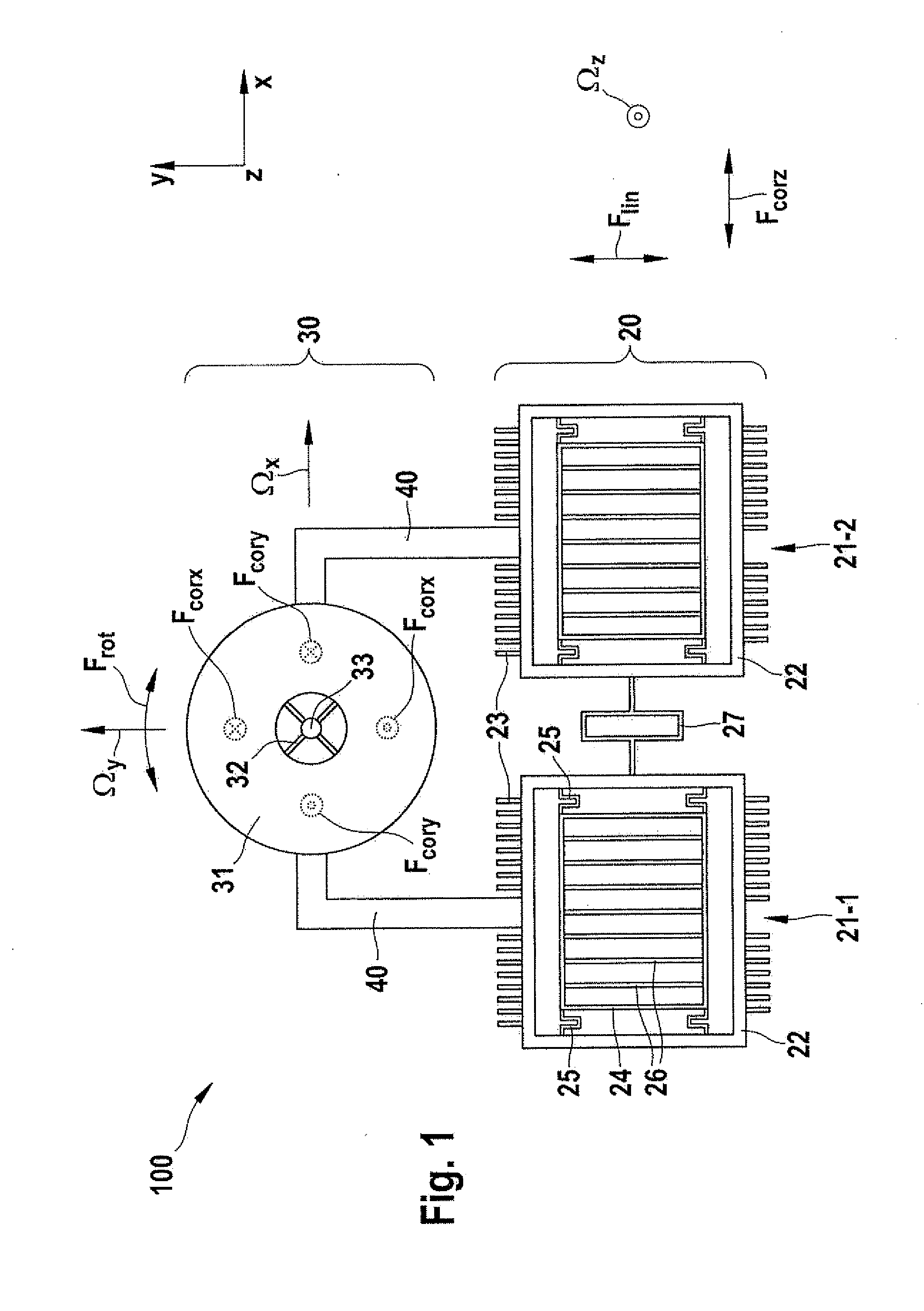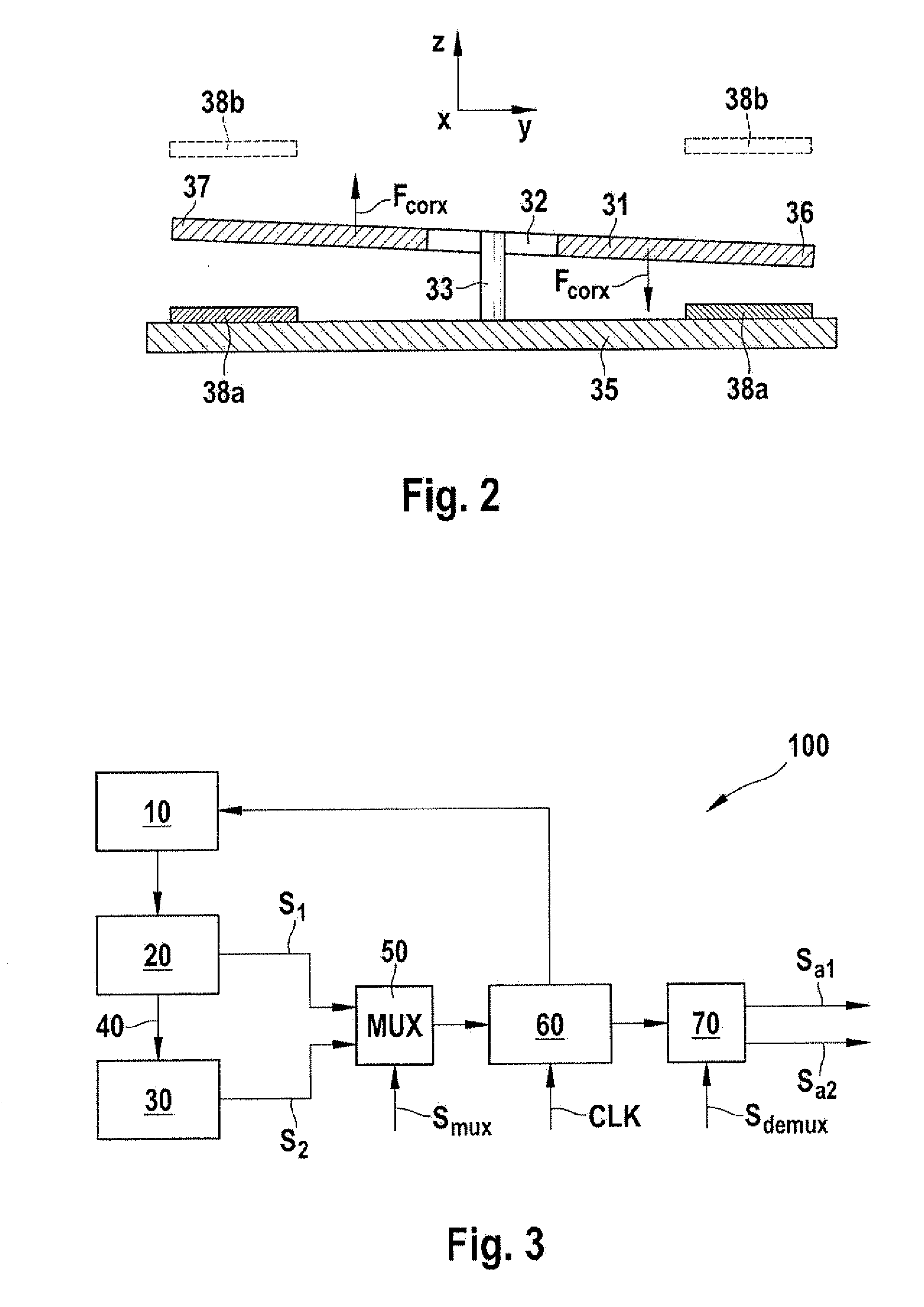Micromechanical yaw-rate sensor
a micro-mechanical and sensor technology, applied in the direction of acceleration measurement using interia force, turn-sensitive devices, instruments, etc., can solve the problem of insufficient detection of rotation around two rotational axes
- Summary
- Abstract
- Description
- Claims
- Application Information
AI Technical Summary
Benefits of technology
Problems solved by technology
Method used
Image
Examples
first exemplary embodiment
[0024]FIG. 1 is a diagram of a yaw-rate sensor 100 as per a first specific embodiment according to the present invention.
[0025]Yaw-rate sensor 100 has a first yaw-rate sensor element 20 and a second yaw-rate sensor element 30, which are coupled to one another via coupling links 40.
[0026]Yaw-rate sensor element 20 is designed as a two-mass system having two linear oscillators 21-1, 21-2. The two linear oscillators 21-1, 21-2 are mechanically coupled to one another via a spring 27. Each of two linear oscillators 21-1, 21-2 has a drive frame 22, a plurality of drive electrodes 23 being provided on each of two diametrically opposite sides of drive frame 22. A detection frame 24 which is connected to drive frame 22 via spring elements 25 is situated inside drive frame 22. It is also possible to connect detection frame 24 via a further frame, which is mounted between detection frame 24 and drive frame 22, as well as to connect corresponding spring elements to detection frame 24, in order ...
second exemplary embodiment
[0051]FIG. 5 is a diagram of a yaw-rate sensor 200 according to a second specific embodiment of the present invention. Elements which have identical construction or function as elements of the first specific embodiment are identified using identical reference numerals and are not explained in greater detail. This also applies for the following exemplary embodiments.
[0052]Yaw-rate sensor 200 as per a second specific embodiment according to the present invention has two linear oscillators 21-1, 21-2 as first yaw-rate sensor element 20 and two rotational oscillators 30-1 and 30-2 as second yaw-rate sensor elements 30. Linear oscillator 21-1 is mechanically coupled via a coupling web 40 to one rotational oscillator 30-1, and linear oscillator 21-2 is mechanically coupled via a coupling web 40 to other rotational oscillator 30-2. Coupling webs 40 are each connected at one end to one of drive frames 22 and at their other end to the circumference of particular oscillating body 31. Oscillat...
third exemplary embodiment
[0055]FIG. 6 is a diagram of a yaw-rate sensor 300 according to a third specific embodiment of the present invention.
[0056]In this yaw-rate sensor 300, a first yaw-rate sensor element 20, which has two linear oscillators 21-1, 21-2, and two rotational oscillators 30-1 and 30-2 are situated adjacent to one another in a row. Two rotational oscillators 30-1 and 30-2 are situated between linear oscillators 21-1, 21-2 and are each connected via a coupling web 40 to adjacent linear oscillators 21-1, 21-2. Rotational oscillators 30-1 and 30-2 are connected to one another via a spring element 80.
[0057]Generally the same advantages result with this specific embodiment as in the first and the second specific embodiments.
PUM
 Login to View More
Login to View More Abstract
Description
Claims
Application Information
 Login to View More
Login to View More - R&D
- Intellectual Property
- Life Sciences
- Materials
- Tech Scout
- Unparalleled Data Quality
- Higher Quality Content
- 60% Fewer Hallucinations
Browse by: Latest US Patents, China's latest patents, Technical Efficacy Thesaurus, Application Domain, Technology Topic, Popular Technical Reports.
© 2025 PatSnap. All rights reserved.Legal|Privacy policy|Modern Slavery Act Transparency Statement|Sitemap|About US| Contact US: help@patsnap.com



